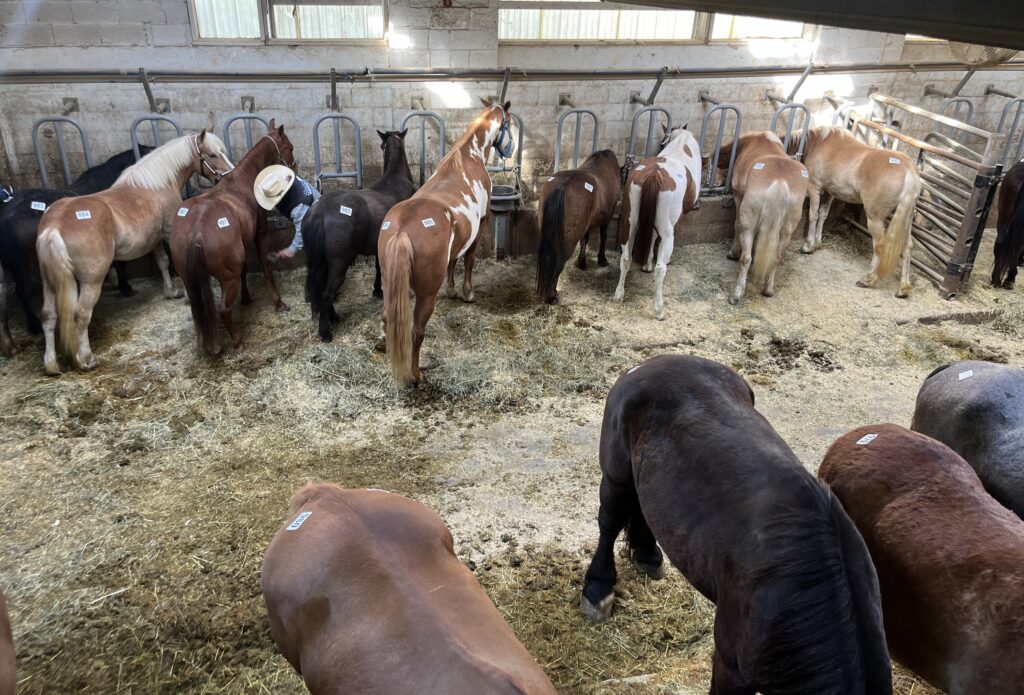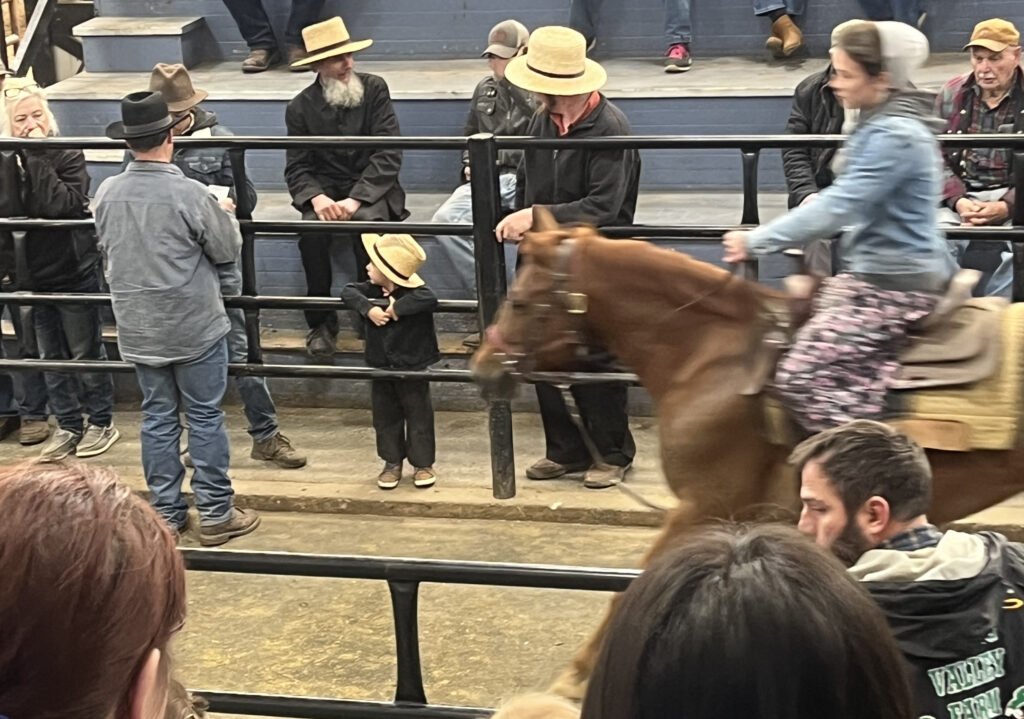At the Five Hundred Ponies Sale

Photograph by Alyse Burnside.
I arrived in New Holland, Pennsylvania early, around 7 A .M., and drove down the main street, taking in the produce stands, machine repair shops, and country stores that bear Mennonite names: Yoder, Yoacum, Yost. Cattle graze in unpeopled fields, and in one, three Staffordshire Draft horses stood obediently, harnessed to a plow, as though posing for a painting.
Lancaster County is home to many auctions, but the New Holland Sales Stables have been a mainstay of the Amish and Mennonite communities since 1920, and boast the largest horse auction this side of the Mississippi. The sale barn auctions more than 150 horses, ponies, mules, and donkeys beginning at 10 A.M. sharp every Monday, rain or shine, regardless of season, and even on holidays.
The barn opened at 8 A.M., so I made my way across the patchwork of Lancaster County’s small towns, through East Earl Township, Blue Ball, and Goodville, past a Christian playground manufacturer with replicas of Noah’s ark, a taxidermy shoppe called Nature’s Accent, Shaker furniture showrooms, saddleries, dozens of churches, and hand-painted signs advertising asparagus, tulips, watermelon, raw milk, whole milk, lemonade, onions, potatoes, homemade berry pies, salvation.
NEW HOLLAND SALES STABLES INC. was painted in faded red capital letters on the corrugated tin barn. The barn was made up of a large central building with a sale arena flanked by stadium bleachers, a concession stand, and an auctioneer’s booth located ringside. A line for the concession stand had formed at the entrance. “Get your hot dogs now, they’ll sell out by ten,” one woman said to her husband. A couple of old Amish men sat on a bench drinking coffee and spitting dip into empty cups or onto the dusty floor in front of them. One wore a thick denim chore jacket over a blue gingham shirt, muddy cowboy boots, and a white straw hat. This seemed to be the uniform—any place can attract regulars. His friend wore a lavender button-down under thick black suspenders. His floppy white hair hung past the brim of his cowboy hat, making it difficult to tell where his head hair stopped and his long white beard began.
I heard about the auction from a coworker of mine at the equine therapy barn in Queens where I used to work as a stablehand. He called it the Five Hundred Ponies Sale because of the large stock of horses available each week. I read a blog post titled “First Time Auction Advice,” which instructed New Holland auction-goers against wearing fancy clothes or bright colors. “The name of the game is ‘blend’. You don’t want to appear to be an outsider and draw unnecessary attention to yourself,” it warned. Most of the horses that find themselves at auctions come from breeders, or have aged out of their hard labor jobs or failed in their roles as birthday party ponies or lesson horses. Some are simply no longer wanted by their owners. The auction decides their next life. They might be sold again as pasture companions, kids’ horses, or carriage horses, and sometimes, they are sold to slaughter.
The horses waited in rows, tied to posts in the alleyways of the smaller barns attached to either side of the sale arena. Each eligible horse was assigned a number, which was printed on a sticker, then affixed to one side of the animal’s hips. I walked down the aisles looking at the horses to be auctioned. I touched their shoulders, their noses, their hindquarters. They flinched, then grew curious, stuck their heads out toward me.

Photograph by Alyse Burnside.
Some of the horses danced around anxiously or pawed at the ground. Others seemed like they’d been sedated—they hardly reacted when I reached out to touch them, their heads dipped down heavily into their hay troughs, eyes like wet marbles. A pair of chestnut Arabians tied to a post got spooked when a small boy cracked a whip against the concrete floor. Hooves beat against the ground, veins popped, nostrils flared. One of them reared and nearly bashed her face against the wooden rafters. A handler shortened her rope, tying her more tightly to the post; patted her hindquarters; and moved on.
At 9 A.M., the tack auction began. The auctioneer, a middle-age man in a gray fleece zip-up, took his seat in a booth at the front of the ring. The crowd trickled in, a constant drone shuffle of cowboy boots on the gritty floor. The room was abuzz with chatter until the auctioneer leaned forward in his folding chair, bringing his mouth to the large table mic in front of him, and began.
Show saddles, bridles, vet wrap, saddle pads, lead ropes, shovels, halters … even horseshoes—the vast umbrella of horse accessories and equipment could be bought at the tack sale. “If your horse needs it, we’ve got it,” the auctioneer sang. I took a seat at the very top of the bleachers. In the ring, a young Mennonite boy in a felt cowboy hat, double denim, and boots walked in a circle, showcasing the merchandise as the auctioneer began calling numbers. The higher the price, the tighter his circles became.
The woman next to me bought twenty-four bottles of fly spray, eight trailer ties, five seven-foot lead ropes, ten neon-green-and-pink water buckets, and eight children’s lassos—for a fraction of the price she’d pay at a Tractor Supply Co. or saddlery. “I hope you buy horses the way you buy tack,” the auctioneer joked. “I’m trying,” the woman said.
Behind me, a miniature pony began kicking wildly at her neighbors. She stood no more than four feet tall, her flaxen mane was long and crimped, her tail tied with a red bow—she was well-fed, shiny and dappled, with feet polished black like a Breyer Horse’s. As if by her demand, the horse auction finally began. There were two categories of horses for auction: “as is” and “sound.” A sound horse is physically fit for riding, while the “as is” designation guarantees nothing about the horse’s health. There was a vet on the premises to offer a preliminary look at any of the horses available, but he was on the auction’s payroll and couldn’t speak to their wellness aside from general impressions. Sound horses began at a thousand dollars, “as is” at a hundred.
It’s widely known that kill-pen dealers are regulars at auctions. Kill-pen dealers, or vendors who buy horses to sell them for slaughter, are contracted by companies in Mexico and Canada, where, unlike in the U.S., horses can be sold for meat. Or dealers will capitalize on the sympathies of horse rescues in the U.S., selling them for a higher price than they would make at slaughter.
I noticed two men leaning against the ring. One chewed gum like the Energizer Bunny, the other remained expressionless as he bid three hundred dollars on a thirteen-year-old Standardbred mare, “as is.” The slightest flick of his wrist caught the auctioneer’s attention. For a few hundred dollars a piece, two, then five, then seven “as is” horses belonged to him. It was clear this was not the man’s first euphemistic rodeo.
Then the first “sound” horse was announced. A six-year-old gray quarter horse pony with a broad face and short-cropped mane that stuck up like a mohawk. He belonged to the auctioneer himself, bought for his daughter who had since “tired of him,” he said with a chuckle. A young Amish woman wearing blue riding breeches under her long floral dress cantered him down the ring, stopped him on a dime, then spun him quickly and rode back to the gate. The bidding started at a thousand dollars. “Onethousandonetwotowandaquarterthreecanigetthreeandaquarter, once, twice, one, three, andaquarter.” With that, the auctioneer’s daughter’s horse was sold to a flinty-looking middle-age woman in stonewashed jeans, worn Wrangler boots, spurs, and a faded T-shirt that read, “I’d get a job but my horse needs me!”
The woman next to me bid on #408, a sixteen-hand Morgan mare. “Local and guaranteed to ride,” the auctioneer promised. She bid against the Energizer Bunny, who wiped his palm through his slicked-back hair between bids. He leaned against the fence on the other side of the ring, not far from the other dealer. They took turns raising the bid a whole, half, then a quarter, before she won out at $1,825. “Thank you,” she said to her husband as their new mare rode out of the ring. “Congratulations,” I said. “How many do you have?” But the woman was focused on the next eligible horse, not wanting to miss a thing. “Three … four now,” she replied, without breaking her gaze on the auctioneer’s darting wand. A too-thin red roan with small ears and a vulpine face stood at the gate with one foot cocked, dragging it slightly as he trotted in front of the bidders. He went for four hundred dollars to the man with the slicked-back hair. I watched a man across from me house two large hot dogs.
Over the next half hour, dozens of horses were showcased, the rest of their lives in our hands: the auctioneer’s, the handlers’, the crowd’s, the kill-pen dealers’. Buggy horses, yard ponies, off-the-track racehorses, “pasture puffs,” companion seniors, green horses with show potential, workhorses, a small Appaloosa pony with Dalmatian spots, a pair of donkeys advertised as “the very best lawn mowers you can get,” and a scruffy pony with one blue eye who looked just like my childhood horse, Shirley. Shirley I never tired of, but at some point it became too expensive for my parents to keep her, and I came home one day to find her gone. My interminable ache. It occurred to me, sitting there, that she might have ended up at an auction like this one, dancing and throwing her head back before a stone-faced crowd.

Photograph by Alyse Burnside.
Most people leaving the auction with new horses wore an air of something like excitement, but without obvious joy. Perhaps it was the daunting sense of duty, the labor that awaited them—preparing the barn for one more horse, hauling one more hay bale into the barn each day, one more farrier bill, one more horse to ride, to train. Cutting through this apprehension, a young girl stood in front of the barn with her new pony, the number 183 still pinned to his rear. She threw her arms around her pony’s shaggy neck, pealed with glee. Her father pulled his cell phone from his hip holster to snap a photo.
Those leaving without horses seemed like neighbors. They milled about drinking coffee and chatted about the week’s livestock, their wives, husbands, children, and how much rain there’d been already this season. An average Monday at the sale barn.
As I drove out of town, I passed horse trailers on both sides of the highway. Manes and tails blew through slats in the interstate wind. When I reached the New Jersey Turnpike, I turned, and they went wherever it was they went. As is.
Alyse Burnside is a writer living in Brooklyn. They’re working on a collection of essays about work, attachment, and horses. Their work has appeared in The Atlantic, The Believer, The Nation, DIAGRAM, and elsewhere.
Copyright
© The Paris Review
